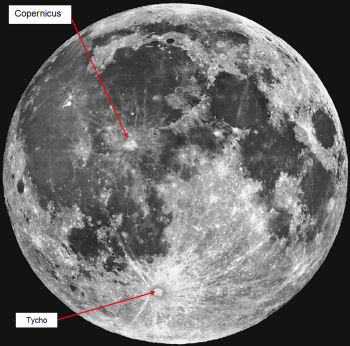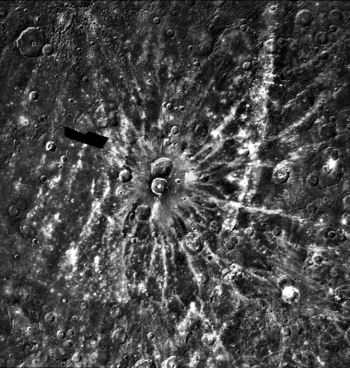LUNAR RAY CRATERS
published: Website 2012-04-22SUMMARY
The Moon has many craters. The youngest of them are the source of long rays which have many conspicuous but non-understood characteristics. A qualitative model as a first step seems to explain the ray craters. Comparisons to craters on Mercury, Venus, Earth, Mars and Ganymede support this electric model which is based on the Langmuir-effect in vacuum.
INTRODUCTION
Fig. 1 shows one side of the Moon with many craters. This beautiful photo of the Hubble Space Telescope in http://imgsrc.hubblesite.org/hu/db/1999/14/images/d/formats/full_jpg.jpg shows thin, long and white rays which can be also seen via binocular at full moon. Perhaps Galileo saw these rays 4 centuries ago, but so far no explanation is known. A model is important also for the understanding of many other astrophysical rays. Moreover, an electric model shows that the future impacts on Earth will not produce ray craters. The impact-crater will not be followed by a covering of an area as large as a country (200000 km2). These rays would additionally kill life with their thickness of e.g. 100 metres and their X-ray within some minutes - far away from the impact.
STRANGE CHARACTERISTICS OF RAY CRATERS
- The crater Tycho (Fig.1) has a diameter of 85 km, the crater Copernicus has the diameter of 93 km. Copernicus should get the higher impact energy. However, the rays of Tycho are thrice longer and even stronger.
- All craters can give a shadow but none of the rays can.
- The impact-craters emit rays. A pure thermal-mechanical model cannot explain that the impact does not produce one big outflow on the opposite side to the meteor-impact. What is the cause of these thin rays which cover 250° all round Tycho?
- If somehow 10-20 thin rays came into existence, why did the rays in the proximity often have nearly the same angle to each other?
- The rays are long (up to 1000km) and straight. Their width is constant and very small (about 10 km). Something unknown constantly controlled them from start up to the end. No gaps on the ring wall produced them. Gaps would create rays in daisy-form.
- The rays of Tycho do not have branches but those of Copernicus do. These branched rays are similar to a lightning with branches which minimize the electric resistance.
- Two rays of Tycho on the left lie parallel to each other. These do not start in the centre of the crater. How can they have a thermal emission?
- Via strong enlarging of the Fig. 1, one has the impression that the rays have a repeated pattern of the length of about 40 km as an oscillation of the diameter.
THE ELECTRIC MODEL OF THE RAY CRATERS
Let us try to model the short story of an impact in its phases of some seconds!
The start of the impact:
The meteor flies onto the Moon
It is cold. It produces, however, a high T temperature of above 3000K around it by the impact-energy. This round and hot lunar area emits electrons as a huge cathode. The start-velocity v of these electrons is more than 300 km/s (according to the Boltzmann-equation:
0.5kT=1.5mv2 (equ.1)
m is the mass of the electron and k is the Boltzmann constant: 1.38 x 10-23J/K).
The cathode
One mm² of a cathode of 1000K emits about 10 milliampere in vacuum, therefore, the hit surface layer of about 100 km² of 1000K emits 1012A. However, a surface of 3000K emits a higher electric current into the vacuum. The emitted electrons in space form an electron-cloud which has the name of “Langmuir electron-cloud”. (Langmuir received the Nobel prize in 1932.) This big cloud does not inhibit the emission of new electrons from the hot lunar areas. Its electric repulsion is low because its electrons are diluted in a huge space of e.g. one million km³. A dynamic equilibrium comes into existence for some seconds: electrons are emitted by the hot and large lunar areas. However, the lost electrons make the hot fluid matter more and more positive, therefore, electrons return from the electron-cloud to the hot areas. However, the electron cloud grows during some seconds due to the growing hot area.
The motion downward and upward
The meteor sinks into the lunar body and quickly the spot of the later ray crater will be hot and fluid by its shockwave. The ring wall starts to elevate by the same cause. After some seconds, however, the motion energy of the meteor has been transformed to a high and oscillating pressure and high temperature of lunar matter. The direction of motion downward elastically returns to upward and melted and vaporised matter explodes in the centre of the crater.
Separation of the electrons from their crater
The exploded vapour as a big, quick and heavy cloud sweeps away the cloud of the light electrons. As long as this vapour with these electrons does not return to the Moon, the fluid lunar matter in the crater remains positive. This process is similar to that in the vacuum diffusion-pump used in the industry. The principle is simple: a tube is closed by a vapour-wall. This thin wall is made via a spray of silicon oil- or mercury-vapour. The light nitrogen and oxygen molecules are mechanically swept away by this wall if they fly into it. A second small pump collects these air molecules. Similarly, the heavy and exploding lunar matter form a big cloud. Not only are the Langmuir-electrons inhibited to return to the positive crater but also the new electrons are swept away by the explosion as soon as they are emitted by the hot and positive crater.
Start of the hot rays is formed and repulsed by their positive charge
The pressed lunar matter below the crater starts to eject the fluid and highly positive matter in the crater. (This positive charge does not flow quickly into the big body of the Moon which is a very weak - dry and rocky - conductor.) The fluid crater-matter starts to fly in all mechanically possible directions repulsed electrically and thermally. But this moved positive matter is an electric current and therefore, it forms thin filaments via pinch-effect. This start process is similar to that of a lightning which is a small and long filament of a diameter of only e.g. 25 mm flowing out from the stormy cloud of many km³. The positive charge causes the beautiful ray-order of these filaments! Parallel electric currents attract each other. Therefore, the stronger filaments attract and incorporate the smaller ones in the proximity. Oppositely, too thick filaments at the start have a high electric repulsion within their body and give over average matter to the filaments in the proximity.
Therefore, all rays distribute matter and get almost the same diameter of 10 km. Also two positive filaments – occasionally starting in a too small angle between them - have a too strong repulsion as long as they have an average angle. This process is similar to that in a magic sphere in which all pink filaments have the same diameter of 3 mm and the same angles between filaments in the proximity. (These filaments also can have branches!) Also penumbral filaments in a circular sunspot have the same diameter and the same angle. The rays on the Moon start as one system ejected electrically and thermally. The result is that Tycho (Fig.1) does not have a strong outflow of e.g. 10° on the opposite side of the impact but very thin rays in a broad angle of 250°! Degas has nearly 360° (Fig.2). The rays can start also at the edge of the crater as those of Tycho via electric repulsion. In short: a disordered explosion is ordered by the positive charge of its matter. The pictures of ray craters were at least twice elected to be shown in the beautiful series “Astronomy Picture Of the Day”. (APOD 2000 Dec.16 and APOD 2001 Aug.9)
Flight of the rays
The rays keep their start-direction. The rays have a conspicuously constant and small diameter of 10 km on the Moon (Fig.1). In flight the pinch-effect continually controlled the small circular cross section of these positive rays. Parallel electric currents attract each other but positive particles repulse each other, therefore, this dynamic diameter could oscillate with the wavelength of 40 km. The rays had a voltage in the range of 106 V, they emitted X-ray. The Moon has normally a weak negative charge due to the solar wind. (This wind is not neutral, since its electrons direct it to the magnetic poles of Earth. Moreover, wind-electrons excite the diluted air producing beautiful colors of the aurora. But we do not see colors of solar matter e.g. of hydrogen which would neutralise the solar wind as protons.) When the positive rays approach the negative Moon after their highest flight, the rays produce branches similar to lightning. Electricity looks for the lowest resistance. This could be the case of Copernicus, Degas and many other ray-craters with short but branched rays. In its maximum, the Sun emits very positive filaments in “proton storms”. Only few hit the Moon. If though the Moon rarely has this strong positive charge at the impact, the emission of rays is stronger, the filaments fly above the positive surface longer and do not form branches. In Fig.1 only Tycho has these very long rays without branches among 60 ray craters on this side of the Moon.
End of the forming of a ray crater
After some minutes, the positive rays fall back onto the Moon. Their circular cross section will be a flat spray which has low edges of e.g. 1m. These edges give no shadow. A disordered spray would have somewhere an altitude of 1000 m and would give a shadow. The lunar highest layer is a good electric insulator formed by small glass spheres. Probably the pinch effect can keep the diameter of 10 km also after the fall. The glass spheres roll in the direction of the flight. After about an hour, the ejected vapour will be dust and falls back. Its huge negative charge due to the collision with the Langmuir-electron cloud will be neutralised by the huge positive charge of the rays. The Moon gets again the weak negative charge it had before the impact. The white rays will be black by the cosmic rays.
RAY CRATERS IN THE SOLAR SYSTEM PROVE THE ELECTRIC MODEL ABOVE
Venus, Earth and Mars?
These planets have an atmosphere. According to the electric model above, they should show impact craters but no ray craters because the vacuum Langmuir-effect does not function. The emitted many electrons collide with the molecules of the atmosphere which have a 50 000 times higher mass. Therefore, the electrons fly only some centimetres in the air and not many kilometres in vacuum after they emitted by the hot areas. These collided near electrons inhibit the emission of new electrons from the hot surface. A Langmuir-cloud cannot come into existence. In fact, the Arizona impact-crater of Earth shows no rays similarly to the Arandas impact crater of Mars. Instead of very long and thin filaments, only a viscous and formless lava-flow can be found around these craters.

